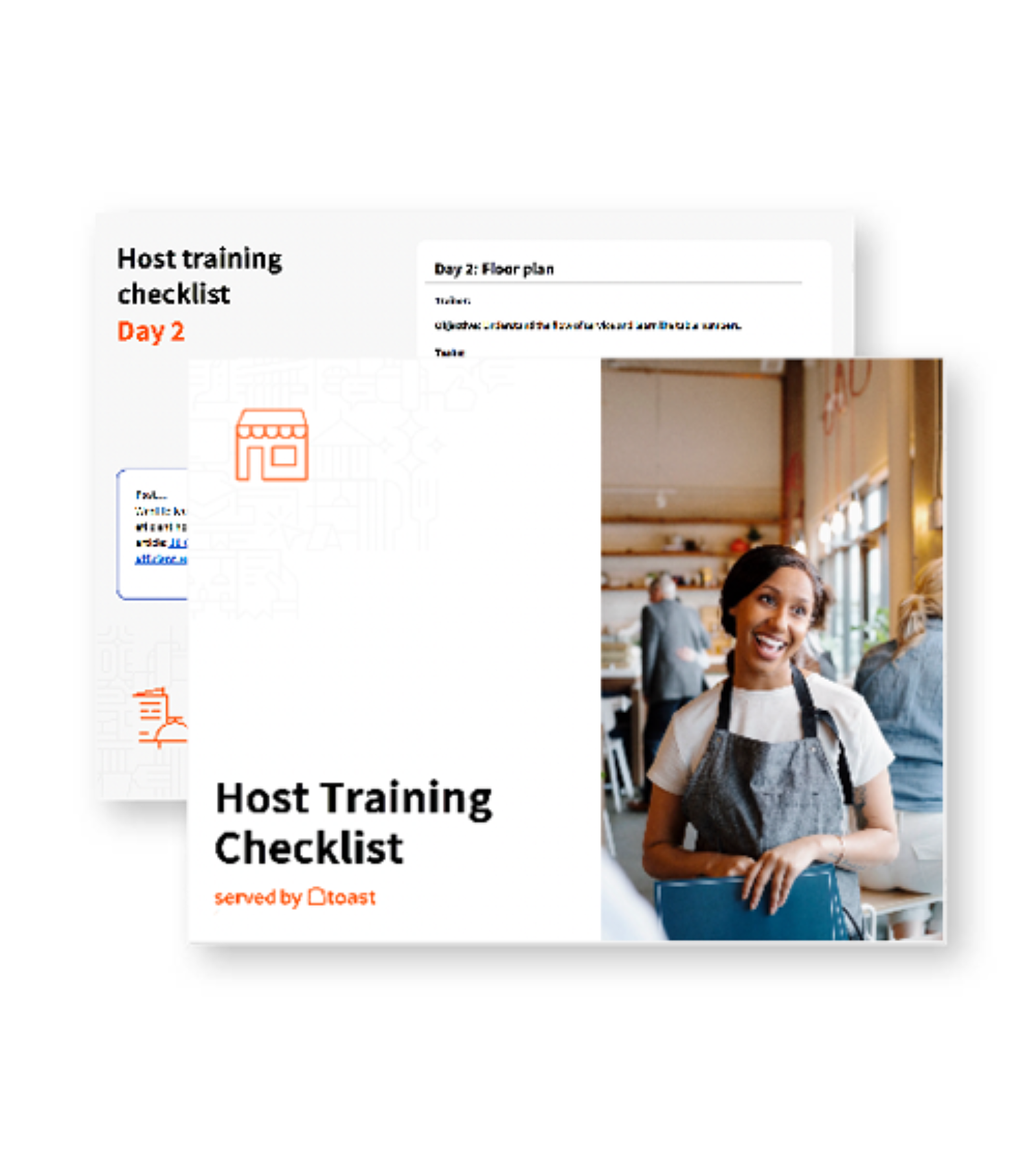
How to Run an Efficient Restaurant Host Stand in 2024
Your host plays an important role in your restaurant. Here are 10 critical tasks to run a more efficient restaurant host stand in 2024.

Tessa ZuluagaAuthor


Host Training Checklist
Use this checklist to help streamline your host training process and ensure that your new hosts get off to a great start.
Get free downloadAs the face of your restaurant, the host plays a critical role in creating a positive first impression for guests. However, your restaurant hosts are more than just a welcoming committee. They set the tone for the entire dining experience and can make or break the efficiency of your restaurant operations.
In this article, we'll discuss tips and strategies for running an efficient restaurant host stand that will leave guests impressed and keep your business running smoothly.
What is a restaurant host stand?
A restaurant host stand is the area of your restaurant in which your host or hostess is stationed during food service. The stand is often located near the entrance of the restaurant or in the waiting area, and it serves as a place for customers to check in for their reservations or pick up takeout. Additionally, the host or hostess provides menus, answers questions about the establishment, and handles customer inquiries or complaints.
10 Critical Tasks for an Efficient Host Stand
At the host stand you can find the host or hostess:
Entering takeout orders on the POS
Looking over the seating chart
Cleaning or stuffing menus
Rolling extra silverware
Checking the online ordering and takeout tablets
That’s right – a host is in charge of a lot more than just seating guests.
Here are the 10 critical tasks for an efficient restaurant host stand.
1. Greet guests
Your restaurant host is commonly the first person guests make contact with when entering your restaurant business. They have the ability to kick off a great dining experience.
Consider giving your host a standard script for greeting guests such as, “Welcome to [insert restaurant name]! Do you have a reservation tonight?”. This helps make sure all guests are being greeted in a timely manner and ensures a consistent experience for all.
2. Manage reservations
The host must be adequately trained in your reservation software. Upon arrival, your hosts should be analyzing your covers for the night and plotting where each one will fit. This way, when walk-ins come in, they know which new tables are available and not being saved for a reservation.
One way to help your hosts manage reservations is by using an integrated waitlist & reservation solution such as Toast Tables.
3. Quote wait times
Your host also keeps track of the waitlist and quotes wait times to restaurant guests. Spoiler alert: verbal wait times aren’t going to be perfect! A host does the best they can to estimate how long a guest will wait for the table. This skill comes with practice. This is where hosts learn a lot of customer service skills, including explaining to the guests why there’s a wait and asking for their patience.
You can simplify this process for your host by implementing restaurant waitlist software.
4. Take charge of seating
It’s the host’s job to consider or deny guests’ seating preferences, explain any limited seating times, and strategically plan where a party should be placed. A host should be able to see an open table and know which party is going there next.
This process can be simplified if one host is on “updates”. This means one host is constantly walking around and updating the status of a table (sat, drinking, eating, cleared, check dropped, bussing needed, cleared). This is the best way to take charge of seating because as soon as a table is “on bus”, the hosts can notify someone on the waitlist, further improving your restaurant's efficiency.
Restaurant Waitlist Template
A template to help your host keep track of walk-ins and provide estimated wait times, keeping guests happy and staff organized.

5. Control the server Rotation
Deciding who gets sat next requires more effort than you may think. A host controls how many guests one waiter may serve in a shift. When deciding which server should be sat next, the host should consider:
The rotation: Whose turn is it?
Party size: How many guests has each server served?
In-time: When did each server get on the floor?
Plotting: Deciding in advance which sections are getting certain big parties.
6. Run online ordering and takeout
Off-premise dining became a popular option during the pandemic and allowed restaurants to increase their sales without increasing the size of their space. Hosts are commonly in charge of taking orders over the phone, entering online orders, and keeping track of tablets. Many restaurants keep takeout at their host stands, leaving the hosts responsible for handing it out to the right customers.
You can also ditch the tablets, and reduce labor costs and order errors with Toast Third Party Delivery Integrations.
7. Note dietary restrictions and special requests
A good host also takes note of any allergies or additional notes a customer may have added to their reservation notes. This way, the host can tell the necessary front-of-house workers about extreme allergies, date night requests, and other accommodations.
For example, a couple may be coming in to celebrate an anniversary with a pre-paid champagne bottle on the table. This would be the host’s responsibility to inform the bartender.
8. Restock supplies
A great host always sets the restaurant up for success. In the same way that your waitstaff has sidework, your hosts should have cleaning and restocking responsibilities. Before hosts leave they should:
Wipe menus down
Set the morning or next day’s menus out
Clean the host stand
Restock silverware
Restock takeout boxes
Plug in anything that needs to be charged (tablets, handhelds, etc.)
Restaurant Opening and Closing Checklist
The beginning and end of a shift can be frantic. Use this free PDF checklist to set your front-of-house staff up for success.

9. Prepare tables for the wait staff
Sometimes tables need to be updated for certain restaurant guests. The host is responsible for grabbing high chairs, moving tables together, or dropping reservation signs. Hosts should also be trained as bussers so that on a busy night, they have the skills to clean a table for the next party. Teamwork makes the dream work!
10. Communicate with all restaurant staff
Because hosts are the first step in the guest experience, they’re constantly being informed by guests. For example, when guests with disabilities come in, the host should let the rest of the staff know, so the correct accommodations can be made. Restaurant hosts should also communicate about tables that should be turned, big-party reservations coming in, and more.
For more, check out this article on how to write a hostess job description.
How technology can help
Although restaurants have an immense amount of responsibility, there is modern technology that can make their job easier.
Reservation Management: This technology can help hosts manage reservations more efficiently by providing tools to create, modify, and cancel reservations. Reservation management software also tracks data such as customer information, booking history, and preferences. This can help the host manage the dining room capacity more effectively.
Waitlist Management: In addition to reservations, technology can assist in managing waitlists for walk-in customers. Hosts can use waitlist management software to record the names of customers who want to be seated, estimate wait times, and send SMS or mobile notifications when their tables are ready.
Table Management: This can help hosts manage tables and seating arrangements efficiently. They can use table management software to view the status of each table, including whether it is vacant, occupied, or reserved. This information can help the host make better decisions about seating arrangements and optimize table turnover.
Online Ordering: Technology can offer online ordering options, which can help hosts manage takeout and delivery orders more efficiently. This can be especially useful during busy periods when the restaurant is at capacity, or for customers who prefer to order ahead.
Overall, modern restaurant technology can help hosts streamline their operations, reduce wait times, and provide a better dining experience for their customers. Toast Tables is your one-stop, integrated waitlist & reservation solution - built to enhance hospitality, simplify table management, and keep guests coming back.
Set your host up for success
The restaurant host stand is crucial in creating a successful dining experience for your guests. By implementing some of these tips and strategies, you can ensure that your host stand operates efficiently, leaving a positive impression on guests and allowing your staff to run smoothly.
Remember to focus on organization, communication, and training to set your host up for success. By doing so, you'll not only improve the overall experience for your guests but also enhance your restaurant's reputation and increase the likelihood of repeat business.
Is this article helpful?
DISCLAIMER: This information is provided for general informational purposes only, and publication does not constitute an endorsement. Toast does not warrant the accuracy or completeness of any information, text, graphics, links, or other items contained within this content. Toast does not guarantee you will achieve any specific results if you follow any advice herein. It may be advisable for you to consult with a professional such as a lawyer, accountant, or business advisor for advice specific to your situation.
Read More
Subscribe to On the Line
Sign up to get industry intel, advice, tools, and honest takes from real people tackling their restaurants’ greatest challenges.



